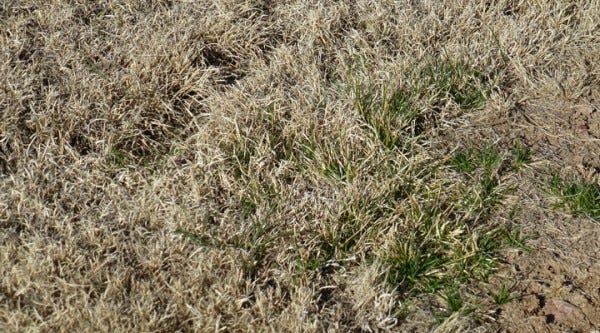Early Spring Maintenance for Your Native Grass Lawn | High Country Gardens
by Wendy

Like any lawn, whether planted with traditional lawn grasses or low water native species, good maintenance practices are essential to keeping them healthy and looking good. I strongly recommend taking a non-chemical, organic approach to lawn care. Use natural and organic fertilizers and avoid the traditional, chemically intensive regimes so heavily advertised in the media. Natural and organic fertilizers will build healthy living soil with improved water retention (less irrigation required) and grow a lawn that's healthier and needs much less frequent mowing.

Early spring weeding of native grass lawns
Native lawn grasses such as 'Hachita' Blue Grama (Bouteloua gracilis) and Legacy® Buffalo (Buchloe dactyloides) are warm season growers. We can take advantage of this characteristic early in the growing season to spot and remove weeds. Warm season grasses go dormant over the winter months turning tan or buff colored until they begin to green up in mid- to late spring. When dormant, it is very easy to spot weeds and invasive cool season grasses (like Kentucky bluegrass) and remove them.

- For smaller lawns, just pull out the dandelion fork and some sturdy gloves and pull the weeds and invasive cool season grasses.
- For larger lawns you can use enhanced 10% vinegar or organic herbicides to spray on the weeds or invasive Kentucky bluegrass to kill them. It may take a couple of applications, but your lawn's weed population will be greatly reduced for the rest of the growing season. The key to using these non-synthetic herbicides is to apply them when the native grass is still dormant. Once the native grass begins to green up (see photo below), then hand weeding is your best option because enhanced vinegar and organic contact herbicides will burn back the non-dormant native grass as well.

Weed and Feed fertilizers: Just say NO, NO, NO!
- Weed and feed fertilizers are some of our most insidious lawn chemicals. They contain broadleaf herbicides that target common broadleaf lawn weeds. However they also cause significant long term damage to the trees, shrubs and perennials whose roots have grown under your lawn. While the damage may not be obvious, these herbicides are being absorbed by these non-grass broadleaf plants every time that they are applied. This leads to chemical damage of the plant's physiology that reduces plant health, negatively affects nutrient absorption from the soil and increases vulnerability to insect attack. So it's worth the extra effort to hand weed and use natural herbicides.
- If you have problems with weed seeds blowing into your native grass lawn, then a natural pre-emergent weed preventer will be helpful. Apply corn gluten at recommended rates on the package. Corn gluten creates a barrier on the soil's surface that prevents weed seed from germinating. But don't use it if you will be doing some spot seeding with grass or wildflower seeds to fill in bare spots.
- I highly recommend developing a tolerance for an imperfect lawn. A few weeds and some patches of clover here and there are just fine. The promise of a perfect, weed-free lawn is a myth propagated by the lawn chemical companies that can only be accomplished by intensive use of chemicals at a huge cost to the environment and your health.

Fertilizing
The best time to fertilize your lawn is in mid-fall. But if you didn't get around to it then, do it now. Again, forget those soil killing, high nitrogen chemical fertilizers and use natural or organic fertilizers mixed with some good quality compost. Apply a top dressing of Yum Yum Mix and compost to the lawn and water it in thoroughly. Dwarf turf-type buffalo grass varieties like Legacy® and Prestige® are heavier feeders than 'Hachita' blue grama grass and benefit from a fall and mid-spring fertilizer application. But never fertilize in the summer! This accelerates the lawn's growth rate, increasing its need for water and the frequency it needs to be mowed.
If you have applied corn gluten in the spring as a natural pre-emergent weed preventer, there is no need to use additional fertilizer. Corn gluten is very high in nitrogen.
Dealing With Moles & Gophers
If you're having problems with moles or gophers burrowing in and around your lawn, use emulsified castor oil products like Chase Mole and Gopher Repellent to deter these horrible pests. Broadcast granules over the lawn and water it in thoroughly. Apply in spring and fall when these animals are most active.

Plant Some Early Spring Color
Warm season lawns like blue grama and buffalo grass wait until mid- to late spring before they green up. So we can take advantage of this characteristic and enjoy lots of colorful flowers by fall planting low growing, early spring bulbs into the grass. (Note that Dog Tuff® is not a good lawn grass for naturalizing bulbs. It's growth habit is so dense and thick that it will choke out the bulbs.) Early blooming bulbs like crocus, dwarf iris, wildflower tulips and miniature daffodils are ideal. Plant them in single variety drifts for maximum visual impact. They begin to go dormant as the native grass turf begins to turn green. Simply give the lawn a mowing or racking to remove the old bulb foliage and your ready to transition into summer.